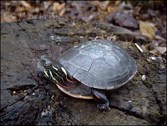Land Turtles
Land turtles are fascinating and fun to learn about. They often are referred to as
mini dinosaurs. Their carapaces (top shell) are domed and legs are scaled to allow
them to travel easily through grasses, forests and dry land. They are found on all
continents as well as on some islands. As the name would suggest, land turtles,
or tortoises, live only on land, unlike their semi-aquatic or aquatic cousins.
Land turtles are the slowest of turtles and tortoises. I often tell people that
while they may be slow, it is their choice. Often times a turtle will be sitting in
one spot and within minutes be out of sight. They are cold blooded, meaning their
temperature is that of the environment around them. This is often why you see them
basking in the sun on cooler days.
Land turtles will visit shallow water sources for a drink or a soak. Their domed shells
do not allow them to swim as easily as the 'streamlined shelled' aquatic turtles,
who also have webbed feet. There are different variations of land turtles, with some
much bigger than others, some with greater longevity than others.
Unlike tortoises, they will stay near water sources and most are omnivores. Their scales
are not as thick as tortoises and most do not live in arid areas that tortoises thrive in.
It is important to remember that no turtle, including the land turtle, will thrive unless
it has the right environment, care, and nutrition to keep it going. Anyone that is
considering a land turtle or any other type of turtle as a pet therefore needs to ensure
that they take the time to learn about its needs, environment, dietary requirements, and
signs of illness amongst other things. All too many turtles get neglected by owners
that thought they would be easy to look after and then quickly lost interest.
mini dinosaurs. Their carapaces (top shell) are domed and legs are scaled to allow
them to travel easily through grasses, forests and dry land. They are found on all
continents as well as on some islands. As the name would suggest, land turtles,
or tortoises, live only on land, unlike their semi-aquatic or aquatic cousins.
Land turtles are the slowest of turtles and tortoises. I often tell people that
while they may be slow, it is their choice. Often times a turtle will be sitting in
one spot and within minutes be out of sight. They are cold blooded, meaning their
temperature is that of the environment around them. This is often why you see them
basking in the sun on cooler days.
Land turtles will visit shallow water sources for a drink or a soak. Their domed shells
do not allow them to swim as easily as the 'streamlined shelled' aquatic turtles,
who also have webbed feet. There are different variations of land turtles, with some
much bigger than others, some with greater longevity than others.
Unlike tortoises, they will stay near water sources and most are omnivores. Their scales
are not as thick as tortoises and most do not live in arid areas that tortoises thrive in.
It is important to remember that no turtle, including the land turtle, will thrive unless
it has the right environment, care, and nutrition to keep it going. Anyone that is
considering a land turtle or any other type of turtle as a pet therefore needs to ensure
that they take the time to learn about its needs, environment, dietary requirements, and
signs of illness amongst other things. All too many turtles get neglected by owners
that thought they would be easy to look after and then quickly lost interest.




